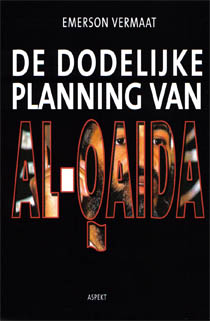(AL-QAEDA’S DEADLY PLANNING)
Maart (March) 2005
ISBN 90-5911-231-8
prijs: 22,95 euro
Verkrijgbaar via de boekhandel of:
Uitgeverij Aspekt (Aspekt Publishers) Amersfoortsestraat 27 3769 AD Soesterberg The Netherlands
Tel. 0346 35 38 95
Fax 0346 35 09 47
e-mail: info@uitgeverijaspekt.nl
De aanslagen van 11 september 2001 waren lang van tevoren voorbereid. In 1997 maakte een Spaanse Syriër in opdracht van Al-Qaida uitgebreide video-opnames van de Twin Towers van het New Yorkse WTC. Die band werd begin 1998 door een speciale koerier naar Osama bin Laden in Afghanistan gebracht.
Na de aanslagen van 11 september zijn er rake klappen uitgedeeld aan Al-Qaida, het terreurnetwerk van Osama bin Laden. Maar Al-Qaida is zeker niet dood of ernstig verzwakt. Bin Laden laat nog steeds van zich horen en ook na ’11 september’ pleegde Al-Qaida aanslagen in Djerba, Casablanca en, in 2004, in Madrid. In Irak speelt Al-Qaida handig in op de chaos die na de interventie van Amerikanen en Britten is achtergelaten. Al-Qaida is nu weliswaar minder hecht en centraal georganiseerd, maar daarom niet minder gevaarlijk.
Ook in Nederland en België zijn Algerijnse en Marokkaanse terreurnetwerken (GSPC, GICM, Takfir wal Hijra, Salafistische Jihad) actief. Deze hebben veelal connecties met Al-Qaida of sympathiseren daar sterk mee. Ze rekruteren jongeren in moskeeën en via internet.
Hoewel Al-Qaida niet achter de moord op Theo van Gogh zat, was de dader – Mohammed B. uit Amsterdam – wel lid van de zogenaamde ‘Hofstadgroep’. Dit terreurnetwerk stond in contact met leden van Al-Qaida elders in Europa, enkele leden van de Hofstadgroep kregen een speciale training in Pakistan van een met Al-Qaida verbonden groepering.

Al-Qaida instrueert leden en volgelingen om na arrestatie tijdens verhoren en rechtszaken alles te ontkennen. Een moslim hoeft zich van ‘ongelovige rechters’ niets aan te trekken omdat hij alleen te maken heeft met het ‘goddelijke recht’.
Inhoudsopgave:
- Al-Qaida
- De moord op Theo van Gogh en de Hofstadgroep
- Radicale moskeeën en ‘terroristenprocessen’
- De Hamburgse Al-Qaidacel en de planning voor 11 september
- De aanslagen in Madrid: ‘En wij houden van de dood!’
- ‘De poorten naar het paradijs’: de aanslagen in Casablanca
- Aanslag op de synagoge van Djerba en experimenten met gifgas: de Tunesische terreurnetwerken in Europa
- Horror in het paradijs: de aanslagen op Bali
Some interesting points:
- Al-Qaeda conducted extensive video reconnaissance of the WTC Twin Towers in New York. This was done by a Syrian migrant in spain who was an associate of Al-Qaida’s top man in Spain, Imad Eddin Barakat Yarkas. The video cassettes were later delivered to Osama bin Laden by his special courier.
- Two important members of al-Qaeda, Ramzi Binalshibh and Khalid Sheikh Mohammed, played a keyrole in preparing the September 11 attacks. They were arrested later and interrogated in the United States. Some of their statements, however, served to protect other Al-Qaeda members, like Mounir Al-Motassadeq, a suspected member of the Hamburg based Al-Qaeda cell led by Mohammed Atta. Binalshibh told his interrogators that Hamburg cell members initially did not intend to go to Afghanistan for training but wanted to go to Chechnya instead. He claimed that an accidental meeting in a train made them to change their minds. In fact, Binalshibh himself was highly instrumental in facilitating the trips to Afghanistan (see pages 115-117).
- At his trial in Brussels, Al-Qaeda operative Nizar Trabelsi claimed that he planned a terrorist attack on the NATO base of Kleine Brögel in Belgium. The real target, however, was the American Embassy in Paris. It was bin Laden’s associate Abu Zubaydah who passed on his master’s order to bomb the Embassy in Paris to Jamal Beghal and Trabelsi when both were in Afghanistan. During the court trials in Brussels, Trabelsi sought to minimize the role of others who were or may have been involved (p. 59-60, p. 212-213).
- Mohammed Atta and members of his Hamburg based Al-Qaeda cell espoused views similar to those of the Nazis. They believed in the total extermination of the Jews (p. 96).
- Marwan Al-Shehhi, one of the September 11 suicide pilots, made a statement to a German Librarian in March 2000 – one and a half year before the terrorists struck. He claimed that there would be thousands of deaths in New York City resulting from an attack on the World Trade Center (p. 96).
- There were ties between the so-called ‘Hofstadgroup,’ Holland’s homegrown terrorist network, and key members of Al-Qaeda in Spain and Italy. Samir Azzouz, a suspected member of the Hofstadgroup, was in touch, posssibly, with Rabei Osman El Sayed. The latter was arrested in Milan, Italy in June 2004. In secret conversations shortly before his arrest, Rabei Osman referred to somebody (or a group) who had just been released from prison and who planned new terrorist attacks. ‘But he is nervous, it will take time.’ He may have meant Samir Azzouz who, along with other Hofstadgroup members, had been released from prison in October 2003, and subsequently planned new terrorist attacks. He may also have referred to the released Hofstadgroup members. Rabei Osman further claimed that the March 11 attacks in Spain had been ‘my project.’ In addition, Samir Azzouz travelled to Spain where he contacted a Moroccan man called Akoudad (‘Nadufel’) . The same Akoudad was also linked to the terrorist attacks in Casablanca (p. 30-32. p. 140-141).
- The terrorist attacks in Madrid were prepared well in advance by key members of Al-Qaida. Their main purpose was to topple the conservative government which was responsible for sending Spanish troops to Iraq, Al-Qaeda’s latest battleground.